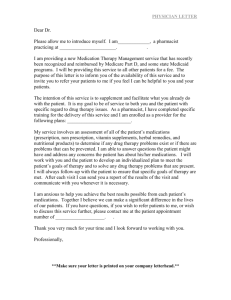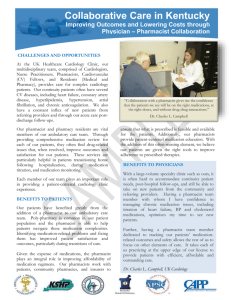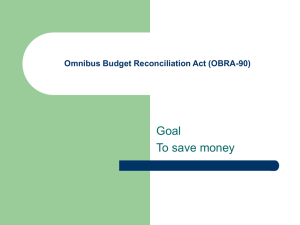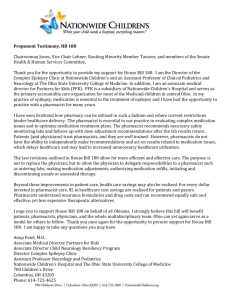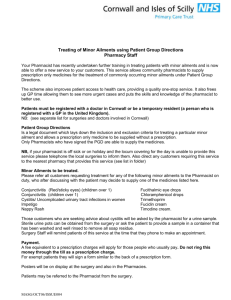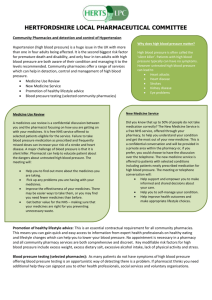Planning a Brown Bag Event - Ohio Hospital Association
advertisement
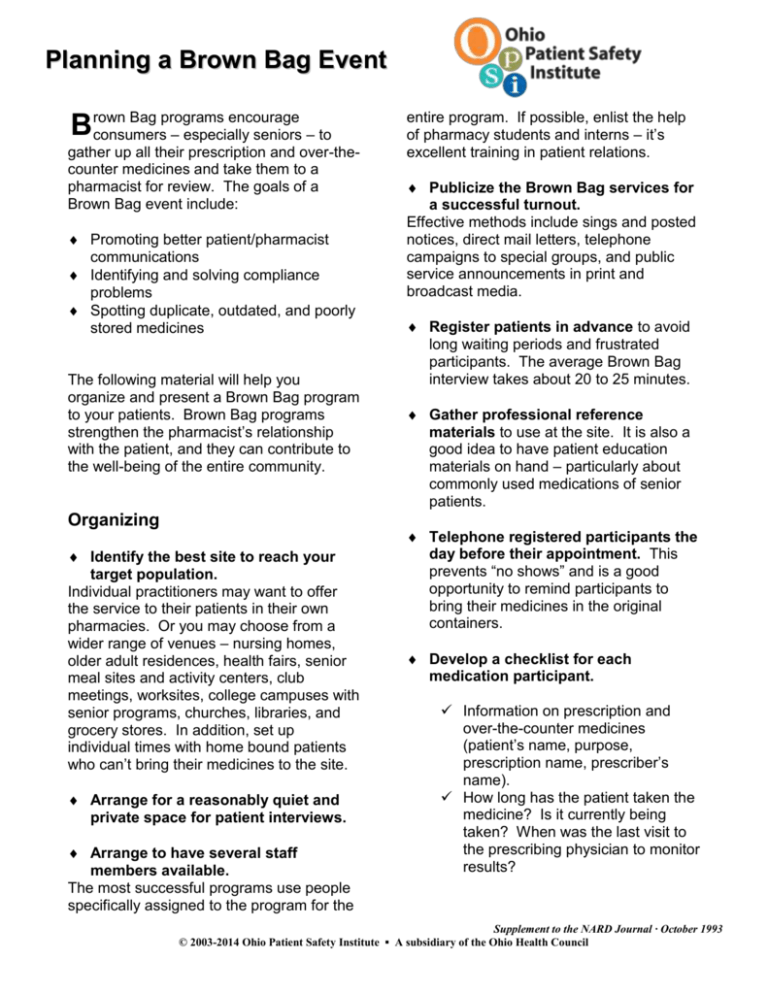
Planning a Brown Bag Event Bag programs encourage Brown consumers – especially seniors – to gather up all their prescription and over-thecounter medicines and take them to a pharmacist for review. The goals of a Brown Bag event include: Promoting better patient/pharmacist communications Identifying and solving compliance problems Spotting duplicate, outdated, and poorly stored medicines The following material will help you organize and present a Brown Bag program to your patients. Brown Bag programs strengthen the pharmacist’s relationship with the patient, and they can contribute to the well-being of the entire community. Organizing Identify the best site to reach your target population. Individual practitioners may want to offer the service to their patients in their own pharmacies. Or you may choose from a wider range of venues – nursing homes, older adult residences, health fairs, senior meal sites and activity centers, club meetings, worksites, college campuses with senior programs, churches, libraries, and grocery stores. In addition, set up individual times with home bound patients who can’t bring their medicines to the site. Arrange for a reasonably quiet and private space for patient interviews. Arrange to have several staff members available. The most successful programs use people specifically assigned to the program for the entire program. If possible, enlist the help of pharmacy students and interns – it’s excellent training in patient relations. Publicize the Brown Bag services for a successful turnout. Effective methods include sings and posted notices, direct mail letters, telephone campaigns to special groups, and public service announcements in print and broadcast media. Register patients in advance to avoid long waiting periods and frustrated participants. The average Brown Bag interview takes about 20 to 25 minutes. Gather professional reference materials to use at the site. It is also a good idea to have patient education materials on hand – particularly about commonly used medications of senior patients. Telephone registered participants the day before their appointment. This prevents “no shows” and is a good opportunity to remind participants to bring their medicines in the original containers. Develop a checklist for each medication participant. Information on prescription and over-the-counter medicines (patient’s name, purpose, prescription name, prescriber’s name). How long has the patient taken the medicine? Is it currently being taken? When was the last visit to the prescribing physician to monitor results? Supplement to the NARD Journal · October 1993 © 2003-2014 Ohio Patient Safety Institute ▪ A subsidiary of the Ohio Health Council How does the patient take the medicine (frequently, schedule, with or without food)? Are there problems that may inhibit proper adherence? Communicate the possible side effects and what to do in the event they experience the side effects. Give the patient information about the proper storage of each medication. Evaluate medication needs and review the patient’s medication review form for: Possible interactions with other medicines Overdoes Appropriateness as a treatment Unnecessary use Avoidable regimen complexity Avoidable side effects Suggest action steps to the patient verbally and in writing. Recommendations may include discarding outdated medications, changing storage procedures, ideas for better adherence, or seeing the doctor to raise concerns about the regimen. Be sure the patient understands the purpose of the medication review and is provided concise instructions about any follow-up with his or her prescribing physician or physicians. Follow up with the patient (or have the patient follow up with his or her pharmacist) at a designated time. Determine whether regimen concerns have been resolved. Consider consulting with the prescriber yourself, as appropriate. Presenting The following outline is an example of what to do on the day of the Brown Bag program. The important thing to remember is that the program meet the needs of the patients it is designed to serve. Set up clearly marked greeting and interview areas. Make you’re your staff is properly equipped with reference materials, patient information material, and the necessary forms. An initial interviewer greets the patient upon arrival. The initial interviewer will take the bag of medications and have the patient fill out a Patient Consent Form (attached) and the top portion of the Medication Review Form (attached). The patient is then introduced to the pharmacist, and the pharmacist receives the bag of medicines and the paperwork. The pharmacist reviews the medications with the patient, following the established checklist of review points. The pharmacist provides verbal and written recommendations to the patient concerning the reviewed medications. Patient information materials will also be provided at this time to help educate the patient. The pharmacist establishes a follow-up time with the patient (or has the patient follow up with his or her pharmacist) and answers additional questions. Supplement to the NARD Journal · October 1993 © 2003-2014 Ohio Patient Safety Institute ▪ A subsidiary of the Ohio Health Council
